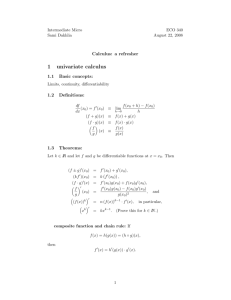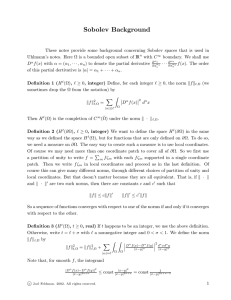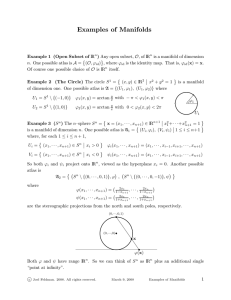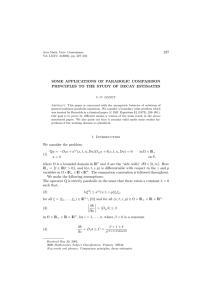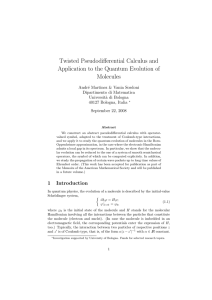X–ray Tomography
advertisement
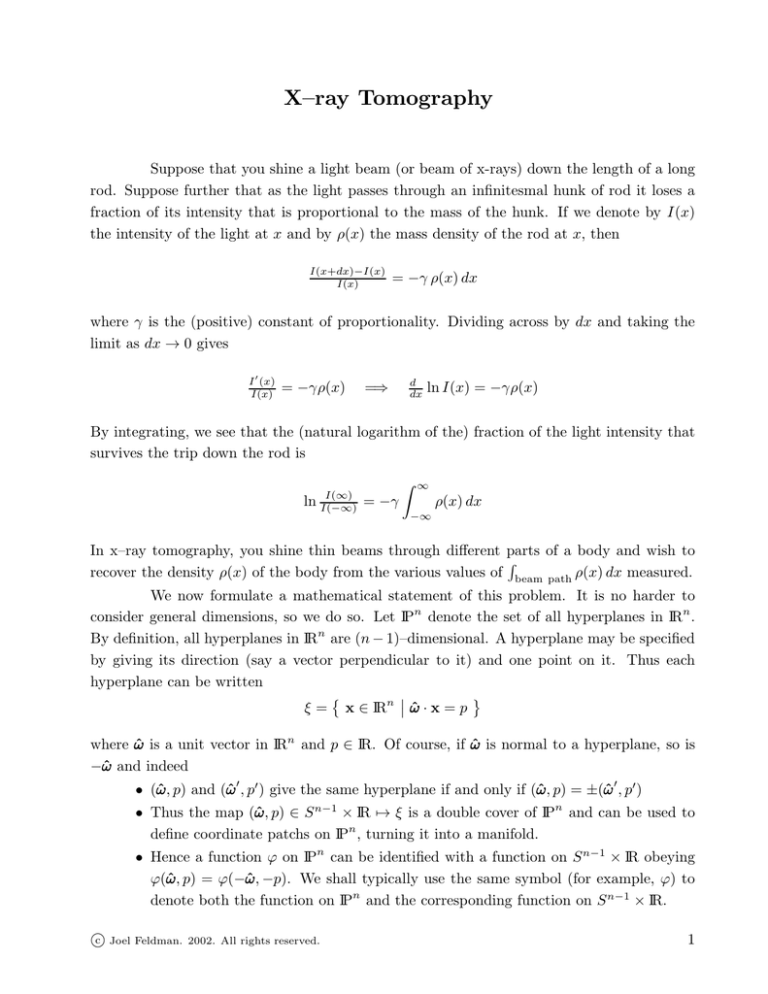
X–ray Tomography Suppose that you shine a light beam (or beam of x-rays) down the length of a long rod. Suppose further that as the light passes through an infinitesmal hunk of rod it loses a fraction of its intensity that is proportional to the mass of the hunk. If we denote by I(x) the intensity of the light at x and by ρ(x) the mass density of the rod at x, then I(x+dx)−I(x) I(x) = −γ ρ(x) dx where γ is the (positive) constant of proportionality. Dividing across by dx and taking the limit as dx → 0 gives I ′ (x) I(x) = −γρ(x) =⇒ d dx ln I(x) = −γρ(x) By integrating, we see that the (natural logarithm of the) fraction of the light intensity that survives the trip down the rod is ln I(∞) I(−∞) = −γ Z ∞ ρ(x) dx −∞ In x–ray tomography, you shine thin beams through different parts of a body and wish to R recover the density ρ(x) of the body from the various values of beam path ρ(x) dx measured. We now formulate a mathematical statement of this problem. It is no harder to consider general dimensions, so we do so. Let IPn denote the set of all hyperplanes in IRn . By definition, all hyperplanes in IRn are (n − 1)–dimensional. A hyperplane may be specified by giving its direction (say a vector perpendicular to it) and one point on it. Thus each hyperplane can be written ξ = x ∈ IRn ω̂ · x = p where ω̂ is a unit vector in IRn and p ∈ IR. Of course, if ω̂ is normal to a hyperplane, so is −ω̂ ω̂ and indeed • (ω̂ ω̂, ω̂ p) and (ω̂ ω̂ ′ , p′ ) give the same hyperplane if and only if (ω̂ ω̂, ω̂ p) = ±(ω̂ ω̂ ′ , p′ ) • Thus the map (ω̂ ω̂, ω̂ p) ∈ S n−1 × IR 7→ ξ is a double cover of IPn and can be used to define coordinate patchs on IPn , turning it into a manifold. • Hence a function ϕ on IPn can be identified with a function on S n−1 × IR obeying ϕ(ω̂ ω̂, ω̂ p) = ϕ(−ω̂ ω̂, ω̂ −p). We shall typically use the same symbol (for example, ϕ) to denote both the function on IPn and the corresponding function on S n−1 × IR. c Joel Feldman. 2002. All rights reserved. 1 Definition (Radon) The Radon transform associates to each function f : IRn → IR the function fˆ : IPn → IR defined by Z ˆ f (ξ) = f (x) dm(x) ξ where dm(x) is the standard Euclidean measure on ξ. We are not going to worry about what regularity should be required of f (x) and what regularity the resulting fˆ(ξ) has. These details are dealt with in the book by Helgason listed in the references. We now pose the Question: Given fˆ, can we determine f ? The short answer is Answer:Yes. We shall justify this short answer by deriving two separate algorithms for determining f . Before doing so, note that once we know how to determine f from its integrals over linear spaces of codimension one, we also know how to determine f from its integrals over linear spaces of higher codimension. For example, the algorithms with n = 2 allow us how to recover a function defined on a planar region from its integrals over lines. As any three dimensional body is a union of planar regions, we can also recover a function on a three dimensional body from its integrals over lines, just by treating planar slices of the body individually. The first algorithm is based on the following Lemma, which shows us how to compute the conventional Fourier transform f˜ of f from its Radon transform fˆ. Of course, once f˜ is known, you find f by applying the inverse Fourier transform to f˜. Lemma. For all s ∈ IR and ω̂ ∈ S n−1 . f˜(sω̂ ω̂) ω̂ = Z ∞ fˆ(ω̂ ω̂, ω̂ r)e−isr dr −∞ Proof: By definition f˜(sω̂ ω̂) ω̂ = Z ω̂ f (x)e−isω̂ω̂·x dn x Z ∞ Z ω̂ = dr dm(x) f (x)e−isω̂ω̂·x IRn −∞ x·ω̂ ω̂=r ω̂ n We have just rewritten the integral over IR as an iterated integral. For, example, if n = 3 and ω̂ = k̂, then dr = dz and dm(x) = dx dy. Subbing in the definition of fˆ, Z Z ∞ −isr ˜ dm(x) f (x) f (sω̂ ω̂) ω̂ = dr e x·ω̂ ω̂=r ω̂ −∞ Z ∞ ω̂, ω̂ r) dr e−isr fˆ(ω̂ = −∞ c Joel Feldman. 2002. All rights reserved. 2 In preparation for the second algorithm we define a dual transform. Definition (Dual) The dual Radon transform associates to each function ϕ : IPn → IR the function ϕ̌ : IRn → IR defined by ϕ̌(x) = Z ϕ(ξ) dµ(ξ) x∈ξ where dµ(ξ) is the unique measure on around x and has mass one. ξ ∈ IPn x ∈ ξ which is invariant under rotations Let’s take a closer look at the measure dµ(ξ). By translating, it suffices to consider x = 0. Then ξ ∈ IPn 0 ∈ ξ is just the sphere S n−1 with antipodal points identified and a function ψ on ξ ∈ IPn 0 ∈ ξ is identified with an even function ψ(ω̂ ω̂) ω̂ on S n−1 . Then, using Ωn to denote the surface area of a unit sphere in IRn , Z ψ(ξ) dµ(ξ) = 0∈ξ = 1 Ωn Z ψ(ω̂ ω̂) ω̂ dω̂ ω̂ S n−1 Z (∗) ψ(Rω̂ ω̂0 ) dR SO(n) where dω̂ ω̂ is the standard Euclidean measure on S n−1 , SO(n) is the group of rotations in IRn , ω̂ 0 is any fixed unit vector in IRn and dR is Haar measure on SO(n). When n = 2, • S n−1 is just the unit circle in IR2 centred on the origin, • dω̂ ω̂ = dθ, where θ is the usual polar angle, • Ω2 = 2π, • the elements of SO(2) are matrices of the form cos θ sin θ − sin θ cos θ with 0 ≤ θ < 2π and may be labelled by the angle of rotation θ. • dR = dθ 2π . To prove that the two right hand sides of (∗) are equal, it suffices to observe that both of R R ω̂0 ) dR are rotation invariant, mass ω̂) ω̂ dω̂ ω̂ and ψ 7→ SO(n) ψ(Rω̂ the maps ψ 7→ Ω1n S n−1 ψ(ω̂ one linear functionals on the space, C(S n−1 ), of continuous functions on S n−1 . (To rotate a function, replace its argument x by R−1 x for some R ∈ SO(n).) There exists only one such linear functional. Lemma. ˇ fˆ = c Joel Feldman. 2002. All rights reserved. Ωn−1 Ωn Z |x − y|−1 f (y) dy IRn 3 Proof: Subbing in the definitions of the Radon transform and the dual transform and then translating and applying the second part of (∗), ˇ fˆ (x) = Z fˆ(ξ) dµ(ξ) x∈ξ Z Z = f (y) dm(y) dµ(ξ) x∈ξ ξ Z Z = f (x + y) dm(y) dµ(ξ) 0∈ξ ξ Z Z = f (x + Ry) dm(y) dR SO(n) ξ0 where ξ0 is any fixed hyperplane through the origin. Observe that as R runs over SO(n), x + Ry runs over the surface of the sphere of radius |y| centered on x. The equality of the R two right hand sides of (∗) says that the integral SO(n) ψ(Rω̂ ω̂0 ) dR is just the average value n−1 of ψ over the sphere S . Hence, ˇ fˆ (x) = = Z Z ξ0 f (x + Ry) dR dm(y) SO(n) Z ξ0 1 Ωn Z S n−1 f (x + |y|ω̂ ω̂) ω̂ dω̂ ω̂ dm(y) Choose ξ0 to be the hyperplane in IRn containing all points whose last coordinate is zero. Call R ω̂) ω̂ dω̂ ω̂ this IRn−1 . Going to spherical coordinates on IRn−1 and observing that S n−1 f (x + |y|ω̂ is a function only of the length of y, Z Z f (x + |y|ω̂ ω̂) ω̂ dω̂ ω̂ dy n−1 S n−1 ZIR∞ Z n−2 = dr r Ωn−1 Ω1n f (x + rω̂ ω̂) ω̂ dω̂ ω̂ 0 S n−1 Z ∞ Z = ΩΩn−1 ω̂ r n−2 f (x + rω̂ ω̂) ω̂ dr dω̂ n ˇ fˆ (x) = 1 Ωn 0 S n−1 This is almost spherical coordinates on IRn . Only the power of r is wrong. So ˇ fˆ (x) = Ωn−1 Ωn Z = Ωn−1 Ωn Z ∞ dr 0 IRn Z dω̂ ω̂ r n−1 S n−1 1 |y| f (x 1 r f (x + rω̂ ω̂) ω̂ + y) dy The change of variables y → y − x does it. c Joel Feldman. 2002. All rights reserved. 4 Lemma. If g(x) = Ωn−1 Ωn R IRn |x − y|−1 f (y) dy, then cf = − ∆ where c = (−4π) n−1 2 n−1 2 g Γ(n/2) . Γ(1/2) “Proof ”: I have put in quotes because we are not going to find the value of the constant c and we are also going to ignore the possible divergence of some integrals. On the other hand, we’ll define what is meant by applying a fractional power of the Laplacian to a function. Note that this is not a problem when the dimension n is odd. In fact, when n = 3, −∆ n−1 2 g = −∆g That is, applying the Laplacian is, up to a constant, the inverse operation for convolving 1 1 . This should not be a surprise. It is just another way of saying that |x−y| is, up to with |x| a constant, the Green’s function for Laplacian in dimension 3. n−1 Note that the claim “cf (x) = −∆ 2 g(x)” is equivalent, by Fourier transforming, to the claim “cf˜(k) = |k|n−1 g̃(k)”. (So, to apply (−∆)α , you Fourier transform, multiply by 1 is |k|2α and Fourier transform back.) So we want to show that the Fourier transform of |x| Ωn c . So we compute |k|n−1 Ωn−1 Z IRn 1 −ix·k n d x |x| e = Z IRn 1 −ix1 |k| n d x |x| e where x1 is the first coordinate of x. Here we have made a change of variables x → Rx, where the rotation R is chosen so that Rk is in the direction of the first coordinate axis. Now 1 making the change of variables x = |k| y Z IRn Since 1 −iy1 n e d y IRn |y| R 1 −ix·k n d x |x| e = 1 |k|n−1 Z IRn 1 −iy1 n d y |y| e is a constant, we are done, up to evaluation of the constant. References • Sirgurdur Helgason, The Radon Transform, Birkhäuser, 1980. c Joel Feldman. 2002. All rights reserved. 5

